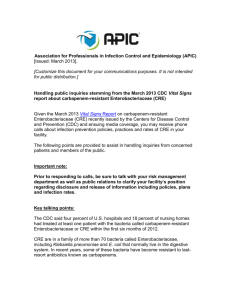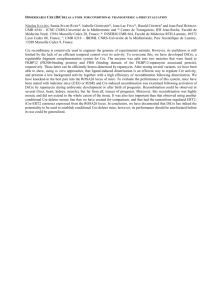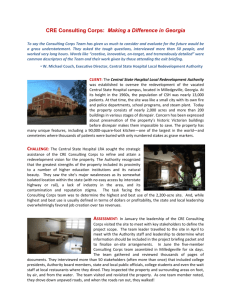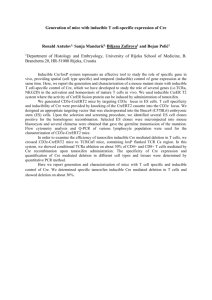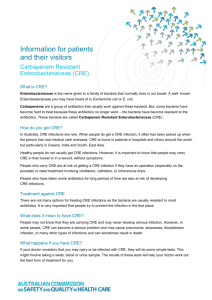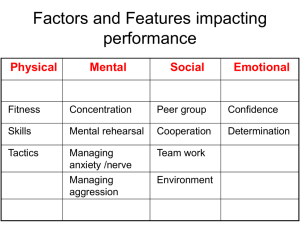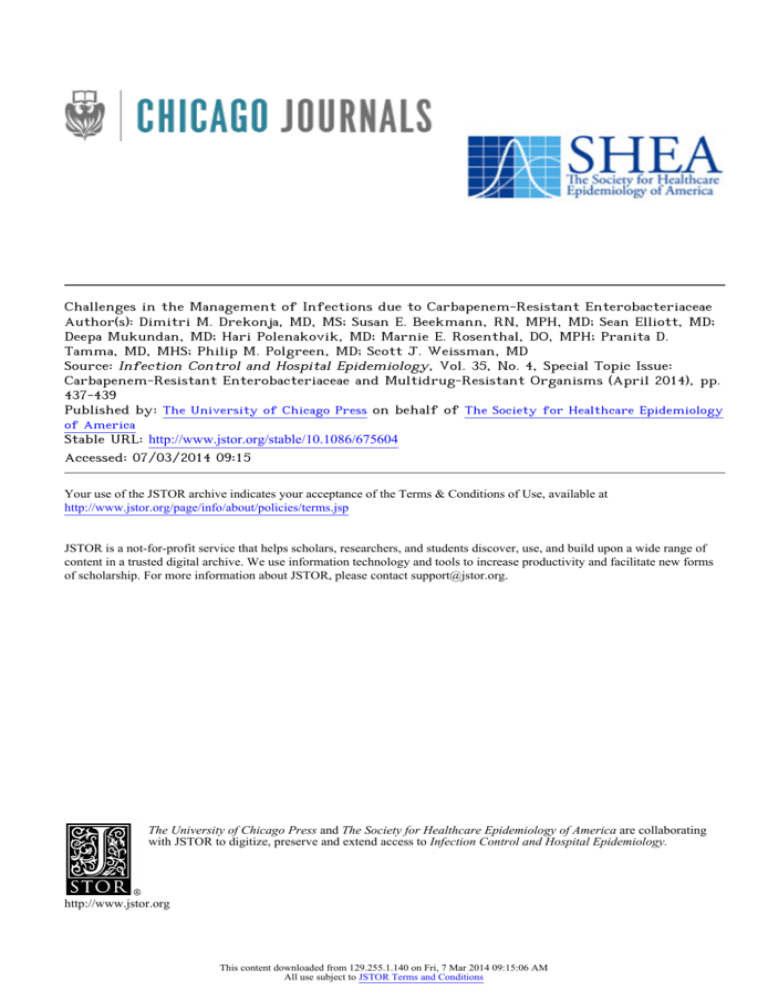
Challenges in the Management of Infections due to Carbapenem-Resistant Enterobacteriaceae
Author(s): Dimitri M. Drekonja, MD, MS; Susan E. Beekmann, RN, MPH, MD; Sean Elliott, MD;
Deepa Mukundan, MD; Hari Polenakovik, MD; Marnie E. Rosenthal, DO, MPH; Pranita D.
Tamma, MD, MHS; Philip M. Polgreen, MD; Scott J. Weissman, MD
Source: Infection Control and Hospital Epidemiology, Vol. 35, No. 4, Special Topic Issue:
Carbapenem-Resistant Enterobacteriaceae and Multidrug-Resistant Organisms (April 2014), pp.
437-439
Published by: The University of Chicago Press on behalf of The Society for Healthcare Epidemiology
of America
Stable URL: http://www.jstor.org/stable/10.1086/675604 .
Accessed: 07/03/2014 09:15
Your use of the JSTOR archive indicates your acceptance of the Terms & Conditions of Use, available at .
http://www.jstor.org/page/info/about/policies/terms.jsp
.
JSTOR is a not-for-profit service that helps scholars, researchers, and students discover, use, and build upon a wide range of
content in a trusted digital archive. We use information technology and tools to increase productivity and facilitate new forms
of scholarship. For more information about JSTOR, please contact support@jstor.org.
.
The University of Chicago Press and The Society for Healthcare Epidemiology of America are collaborating
with JSTOR to digitize, preserve and extend access to Infection Control and Hospital Epidemiology.
http://www.jstor.org
This content downloaded from 129.255.1.140 on Fri, 7 Mar 2014 09:15:06 AM
All use subject to JSTOR Terms and Conditions
infection control and hospital epidemiology
april 2014, vol. 35, no. 4
concise communication
Challenges in the Management of
Infections due to Carbapenem-Resistant
Enterobacteriaceae
Dimitri M. Drekonja, MD, MS;1,2
Susan E. Beekmann, RN, MPH, MD;3 Sean Elliott, MD;4
Deepa Mukundan, MD;5 Hari Polenakovik, MD;6
Marnie E. Rosenthal, DO, MPH;7
Pranita D. Tamma, MD, MHS;8 Philip M. Polgreen, MD;3
Scott J. Weissman, MD9
Carbapenem-resistant Enterobacteriaceae (CRE) infections are increasing and are associated with considerable morbidity and mortality. Members of the Emerging Infections Network treating CRE
encountered difficulties in obtaining laboratory results and struggled
with limited treatment options. In addition, many treated patients
experienced an alarming degree of drug toxicity from CRE therapies.
Infect Control Hosp Epidemiol 2014;35(4):437-439
Multidrug-resistant gram-negative organisms are a major
concern,1 especially since antimicrobial development has stagnated.2 This is particularly true for carbapenem-resistant Enterobacteriaceae (CRE), which are resistant to the traditional
drugs of last resort for serious gram-negative infections. Because CRE are resistant to empiric antimicrobials typically
prescribed for suspected gram-negative infections, effective
therapy may be delayed, increasing morbidity and mortality.
Currently available agents to treat CRE include colistin, tigecycline, and fosfomycin, but each has limitations. Little is
known regarding challenges encountered while treating CRE
infections; we queried Emerging Infections Network (EIN)
members to better understand challenges in treating CRE
infections in the United States.
methods
In July 2012, EIN members were invited to complete a report
form describing their experiences with treating CRE infections to enable a case series. The Centers for Disease Control
and Prevention funds the EIN through a cooperative agreement with the Infectious Diseases Society of America to maintain a provider-based network for emerging infections (http:
//ein.idsociety.org). Because laboratories differ in defining
and detecting CRE, we asked that respondents use their local
laboratory definition. The 17-question report form included
source patient information, treatments, organism information, outcome data, and complications encountered.3 Research oversight committees at the primary investigators’ institutions (D.M.D. and S.J.W.) approved the protocol.
results
An electronic link to the report form was sent to all EIN
members, and 54 members provided information regarding
table 1. Reported Susceptibility Profile of 98 Carbapenem-Resistant Enterobacteriaceae Reported by Respondents
Antimicrobial
Amikacin
Aztreonam
Cefepime
Ceftazidime
Ciprofloxacin
Colistin
Doripenem
Ertapenem
Fosfomycin
Gentamicin
Imipenem
Meropenem
Nitrofurantoin
Piperacillin/tazobactam
Tigecycline
Tobramycin
Trimethoprim/sulfamethoxazole
note.
N
78
52
77
73
92
63
32
54
15
91
74
70
38
78
58
82
87
Susceptible
32
0
9
7
16
52
2
0
11
35
4
8
4
5
31
19
19
(41)
(12)
(10)
(17)
(83)
(6)
(73)
(38)
(5)
(11)
(11)
(6)
(53)
(23)
(22)
Intermediate
11
0
2
0
1
7
3
1
0
3
14
6
3
2
11
3
0
(14)
(3)
(1)
(11)
(9)
(2)
(3)
(19)
(9)
(8)
(3)
(19)
(4)
Resistant
35
52
66
66
75
4
27
53
4
53
56
56
31
71
16
60
68
Data are no. (%), unless otherwise indicated.
This content downloaded from 129.255.1.140 on Fri, 7 Mar 2014 09:15:06 AM
All use subject to JSTOR Terms and Conditions
(45)
(100)
(86)
(90)
(82)
(6)
(84)
(98)
(27)
(58)
(77)
(80)
(82)
(91)
(28)
(73)
(78)
438
infection control and hospital epidemiology
april 2014, vol. 35, no. 4
table 2. Demographic and Travel Characteristics of the 85
Source Patients from Whom 98 Carbapenem-Resistant Enterobacteriaceae (CRE) Were Isolated
Characteristic
Patients
a
Age, median, years
Sex
Male
Female
Not reported
Race
White
Black
Hispanic
Asian
Unknown/other
Travel outside United States in 6 months prior to
CRE isolation
No
Yes
Unknown
Received medical care outside United States in 6
months prior to CRE isolation
No
Yes
Unknown
31
46 (54)
35 (41)
4 (5)
40
14
10
3
18
(47)
(16)
(12)
(4)
(21)
66 (78)
12 (14)
7 (8)
73 (86)
6 (7)
6 (7)
note. Data are no. (%), unless otherwise indicated.
a
Age range, 1 month to 189 years.
85 source patients; for 13 patients, information on 2 separate
CRE was provided, for a total of 98 isolates. Hospital settings
represented by respondents included university (24), nonuniversity teaching (13), community (8), Veterans Administration/Department of Defense (5), and city/county (4) facilities. Infections were reported from 22 states, with the most
reports from California (20), Pennsylvania (19), and Ohio
(8). An additional 213 respondents indicated that CRE infections were not encountered in their practice.
Reported pathogens included 68 Klebsiella species; 12 Enterobacter species; 12 Escherichia coli; 2 Citrobacter species;
and 1 each of Proteus, Pseudomonas (though not an Enterobacteriaceae), Salmonella, and Serratia species. Antimicrobial resistance was prevalent (Table 1), with only 3 drugs
testing as susceptible for more than 50% of the isolates (tigecycline, fosfomycin, and colistin). Colistin was the drug to
which the highest percentage of isolates was susceptible
(83%), but susceptibility was known for only 63% of isolates.
Fosfomycin susceptibility testing was even less common, with
only 15% of isolates tested.
Our series included both pediatric and adult patients with
a median age of 31 years, with 11% younger than 18 years
of age (Table 2). Travel or medical care outside the United
States in the 6 months prior to CRE isolation was infrequent,
with the most common destination being India (n p 4).
Underlying medical conditions and risk factors for acquiring
a drug-resistant organism at the time of CRE isolation were
frequent and included hospitalization or surgery in the prior
6 months (79%) and chronic kidney disease (21%); only 5%
of patients were without chronic medical conditions. Common sites of CRE isolation were urine (39%), blood (34%),
and sputum (15%).
At the time of CRE isolation, most patients (91%) were
hospitalized, with 48% for more than 4 weeks. Almost onefifth of patients (19%) were in an intensive care unit at the
time of CRE isolation, and in 28% of these patients, the CRE
infection was considered to have necessitated the intensive
care unit care. Overall, 57 patients died (67%); however, respondents reported that death was attributable to the CRE
infection for only 16% of these patients. For 76% of patients,
the CRE infection was judged to have caused or prolonged
the hospitalization.
The most common management challenges were the inability to use first-line antimicrobials (65%), the need to use
antimicrobials with increased risk of toxicity (56%), the need
to use parenteral antimicrobials due to lack of oral options
(44%), and a manifested drug toxicity (16%). Reported toxicities included renal dysfunction (colistin) and pancreatitis
(tigecycline). In 11 of 14 patients experiencing drug toxicity,
the implicated drug was used because of the patient’s CRE
resistance profile. Reported challenges did not differ appreciably between the pediatric and adult cases. Other reported
challenges included discordant susceptibility results with different testing methods, lack of interpretive criteria for colistin,
and inability to obtain susceptibility testing for fosfomycin.
discussion
This EIN case series provides insight into hurdles associated
with the management of CRE infections from a geographically
diverse group of infectious disease specialists in the United
States. Only tigecycline, colistin, and fosfomycin were active
against more than 50% of the isolates tested, and susceptibility
testing was not commonly performed for each drug. Comorbidities were frequent, with only a small minority of patients having no chronic medical conditions or healthcare
exposure.
There are few antimicrobials available to treat CRE, and
all have substantial limitations, including nephro- and neurotoxicity (colistin),4 unavailability of a parenteral formulation (fosfomycin), concerns about inadequate blood levels
(tigecycline),5 and increased mortality (tigecycline).6 Surprisingly, susceptibility testing to these agents was often not obtained, and respondents reported difficulty in obtaining and
interpreting the results of such testing. Of these 3 antimicrobials, susceptibility testing was most commonly performed
for colistin (64%), followed by tigecycline (59%) and fosfomycin (15%). Since the EIN is comprised of infectious
disease physicians, difficulty in obtaining and interpreting
susceptibility results may be even more challenging for non–
infectious disease providers, who may be unaware of the limited treatment options available and where isolates might be
sent for testing. Ensuring that providers are aware of these
This content downloaded from 129.255.1.140 on Fri, 7 Mar 2014 09:15:06 AM
All use subject to JSTOR Terms and Conditions
challenges in cre management
first-line agents for CRE infections and that appropriate susceptibility testing is available should be a high priority for all
healthcare facilities.
Additional management challenges were reported by the
majority of respondents. Most indicated that they were unable
to use what they considered to be first-line agents or had to
use a parenteral agent when otherwise an oral agent would
have been indicated, potentially exposing patients to additional risks, including those associated with the need for longterm intravenous access. While the questionnaire did not
elicit a comprehensive antimicrobial history for each reported
case, antimicrobial agents mentioned in the comments included colistin, tigecycline, extended-infusion carbapenems,
ciprofloxacin, and trimethoprim/sulfamethoxazole. Although
ciprofloxacin and trimethoprim/sulfamethoxazole are both
relatively nontoxic and convenient, colistin and tigecycline
have the previously discussed disadvantages. Extended infusions of carbapenems is a strategy used to optimize drug
levels, although the effectiveness of this strategy for the treatment of CRE infections is unknown. No respondents utilized
colistin plus rifampicin, a strategy used in non-CRE gramnegative infections.7
Potential limitations include recall bias—with respondents
preferentially reporting cases that are difficult to manage—
or increased reporting from areas newly affected by CRE.
Conversely, clinicians experienced in managing CRE may
view these issues as routine and underreport cases. This may
explain the limited number of cases reported from areas with
a high prevalence of CRE, such as New York,8 where only 4
isolates were reported. Respondent bias is another potential
limitation. CRE cases may have been present at the institutions of the approximately 1,000 EIN members who did not
respond to the survey; the members may have made a decision not to report them. Thus, the cases reported herein
may not be representative of all CRE cases that might have
been available through the EIN network.
This report provides details regarding clinical challenges that
a geographically diverse group of EIN members encountered
during the management of CRE infections, including problems
with susceptibility testing, the necessity of using antimicrobials
with increased toxicity, and the lack of oral options. These
issues are likely more challenging without access to an infectious disease consultant, a situation that will become increasingly common as CRE continue to proliferate. Efforts to control
the spread of CRE, improve access to appropriate susceptibility
testing, and further investigate the safest and most effective
treatment strategies should be prioritized.
acknowledgments
This series was compiled with the assistance of the Emerging Infections
Network.
Financial support. This publication was supported by the Cooperative
439
Agreement 5U50CK000187 from the Centers for Disease Control and Prevention. Its contents are solely the responsibility of the authors and do not
necessarily represent the official views of the Centers for Disease Control
and Prevention. The resources of the Minneapolis Veterans Affairs Health
Care System supported this research.
Potential conflicts of interest. All authors report no conflicts of interest
relevant to this article. All authors submitted the ICMJE Form for Disclosure
of Potential Conflicts of Interest, and the conflicts that the editors consider
relevant to this article are disclosed here.
Affiliations: 1. Minneapolis Veterans Affairs Health Care System, Minneapolis, Minnesota; 2. Department of Medicine, University of Minnesota,
Minneapolis, Minnesota; 3. Department of Internal Medicine, Carver College of Medicine, University of Iowa, Iowa City, Iowa; 4. Department of
Pediatrics, University of Arizona, Tucson, Arizona; 5. Department of Pediatrics and Department of Medical Microbiology and Immunology, University of Toledo College of Medicine, Toledo, Ohio; 6. Department of Internal Medicine, Boonshoft School of Medicine, Wright State University,
Dayton, Ohio; 7. Department of Medicine, Section of Infectious Diseases,
Jersey Shore University Medical Center, Neptune, New Jersey; 8. Department
of Pediatrics, Johns Hopkins University School of Medicine, Baltimore, Maryland; 9. Center for Childhood Infections and Prematurity Research, Seattle
Children’s Research Institute, Seattle, Washington.
Address correspondence to Dimitri M. Drekonja, MD, MS, Infectious
Diseases (111F), Veterans Affairs Medical Center, 1 Veterans Drive, Minneapolis, MN 55417 (drek0002@umn.edu).
Received July 30, 2013; accepted November 6, 2013; electronically published March 6, 2014.
䉷 2014 by The Society for Healthcare Epidemiology of America. All rights
reserved. 0899-823X/2014/3504-0019$15.00. DOI: 10.1086/675604
references
1. Centers for Disease Control and Prevention. Vital signs: carbapenem-resistant Enterobacteriaceae. MMWR Morb Mortal Wkly
Rep 2013;62(9):165–170.
2. Boucher HW, Talbot GH, Bradley JS, et al. Bad bugs, no drugs:
no ESKAPE! an update from the Infectious Diseases Society of
America. Clin Infect Dis 2009;48(1):1–12.
3. Emerging Infections Network (EIN). Carbapenem-Resistant Enterobacteriaceae Infections: A Case Series. Iowa City, IA: EIN, 2012.
http://www.int-med.uiowa.edu/Research/EIN/CREcaseseries
_form.pdf.
4. Lim LM, Ly N, Anderson D, et al. Resurgence of colistin: a review
of resistance, toxicity, pharmacodynamics, and dosing. Pharmacotherapy 2010;30(12):1279–1291.
5. Gardiner D, Dukart G, Cooper A, Babinchak T. Safety and efficacy
of intravenous tigecycline in subjects with secondary bacteremia:
pooled results from 8 phase III clinical trials. Clin Infect Dis 2010;
50(2):229–238.
6. Prasad P, Sun J, Danner RL, Natanson C. Excess deaths associated
with tigecycline after approval based on noninferiority trials. Clin
Infect Dis 2012;54(12):1699–1709.
7. Durante-Mangoni E, Signoriello G, Andini R, et al. Colistin and
rifampicin compared with colistin alone for the treatment of
serious infections due to extensively drug-resistant Acinetobacter
baumannii: a multicenter, randomized clinical trial. Clin Infect
Dis 2013;57(3):349–358.
8. Bratu S, Landman D, Haag R, et al. Rapid spread of carbapenemresistant Klebsiella pneumoniae in New York City: a new threat
to our antibiotic armamentarium. Arch Intern Med 2005;165(12):
1430–1435.
This content downloaded from 129.255.1.140 on Fri, 7 Mar 2014 09:15:06 AM
All use subject to JSTOR Terms and Conditions




